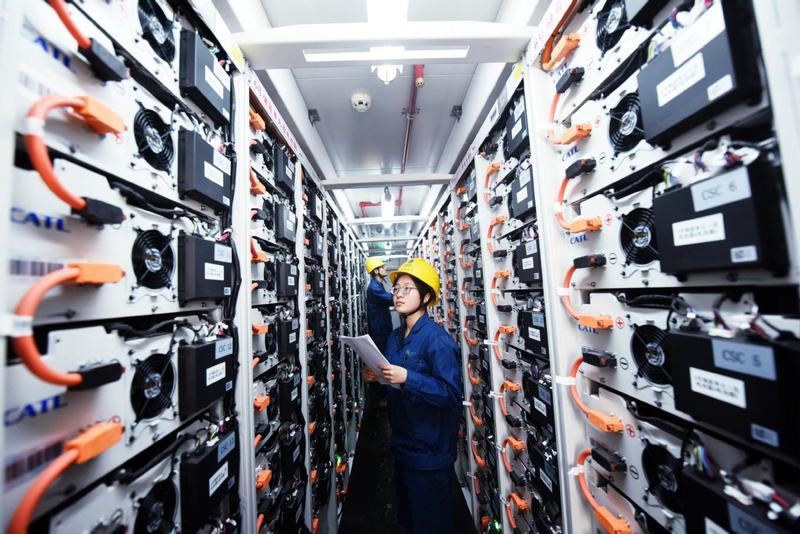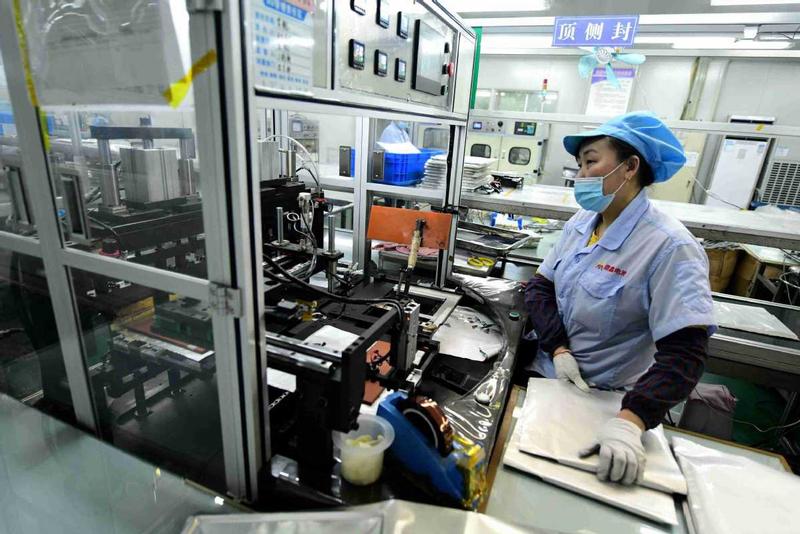Amid green efforts nationwide to achieve carbon goals, experts call for more breakthroughs in industry to tackle key issues
 CATL employees check power storage equipment at a power station in Hangzhou, Zhejiang province, in April. (LONG WEI / FOR CHINA DAILY)
CATL employees check power storage equipment at a power station in Hangzhou, Zhejiang province, in April. (LONG WEI / FOR CHINA DAILY)
Buoyed by the rapid growth in the renewable energy industry and strong policy support, China's development of power storage is on the cusp of a growth spurt which will generate multi-billion dollar businesses, experts said.
An AVIC Securities report projected major growth for China's power storage sector in the years to come: The country's electrochemical power storage scale is likely to reach 55.9 gigawatts by 2025-16 times higher than that of 2020-and the power storage development can generate a 100-billion-yuan (US$15.5 billion) market in the near future.
There still could be potential dangers caused by lithium-ion batteries as they can cause fires or explosions due to technical or quality issues. The industry still needs to ramp up efforts to make breakthroughs in concerning technologies
Lin Boqiang, head of the China Institute for Studies in Energy Policy at Xiamen University
Industry estimates show that China's power storage industry will have up to 100 million kilowatts of installed capacity by 2025, and 420 million kW installed capacity by 2060, attracting related investment of over 1.6 trillion yuan, said Li Jie, general manager of power storage at State Grid Integrated Energy Service Group Co Ltd.
CITIC Securities also forecast that development of new types of power storage and pumped-storage hydroelectricity is set for explosive growth during the 14th Five-Year Plan period (2021-25).
Experts said developing energy storage is an important step in China's transition from fossil fuels to a renewable energy mix, while mitigating the impact of new energy's randomness, volatility, intermittence on the grid and managing power supply and demand.
"Developing power storage is important for China to achieve green goals. With increasing use of wind and solar power, the market prospect of power storage is very promising," said Liu Jing, associate dean and professor of accounting and finance at the Cheung Kong Graduate School of Business.
"In the past, coal was merely the only source of electricity, and many grid operators do not store energy due to high costs. Instead, grid operators normally set up dispatch centers to manage power supply. Demand in peak hours is usually handled by burning more coal," said Lin Boqiang, head of the China Institute for Studies in Energy Policy at Xiamen University.
"Now, solar and wind energies are taking up more in power generation under China's green commitment, and are seeing an increase in their market share as they are becoming cost competitive and advanced in technology development. However, power supply with such energies is intermittent and difficult to be managed in accordance with the power supply.
"To this end, power storage is becoming more prominent in China's transition to green energy as it helps provide uninterrupted power supply and maintain efficient power flow when using intermittent new energies for power generation," said Lin.
The development of power storage is backed by policies. In July, the National Development and Reform Commission and the National Energy Administration co-released a guideline on power storage development.
The guideline called on local governments to roll out development plans which need to clarify goals and key missions during the 14th Five-Year plan period. It urged local governments to encourage construction of power storage projects beside electricity generation plants, and proper distribution of power storage facilities on grids.
The goal is to finish the transition of power storage industry from the early stage of commercialization to a certain scale of development with relatively mature market environment and business models by 2025.Total installed capacity of power storage facilities is expected to exceed 30 million kW by then, the guideline said.
 An employee works on a lithium-ion battery production line in Hai'an, Jiangsu province, in May. (GU HUAXIA / FOR CHINA DAILY)
An employee works on a lithium-ion battery production line in Hai'an, Jiangsu province, in May. (GU HUAXIA / FOR CHINA DAILY)
The country expects to achieve fully market-oriented development of the power storage industry and independent research and development of core technologies and equipment by 2030.
Answering the call, local governments are stepping up efforts promoting the development of power storage.
In August, Shanxi province started to receive the first batch of applications for new energy plus power storage demonstration projects and promised preferential policies to support the development of power storage and related projects.
In the same month, Hebei province vowed to push forward construction of power storage projects beside electricity generation plants and actively promote a proper distribution of power storage system on grids. The province also promised efforts to promote cost cuts and large-scale commercialized application of lithium-ion battery projects.
In addition, some other regions including Shandong, Ningxia, and Qinghai have rolled out supportive policies for the power storage industry. Experts predict more support from local governments in the pipeline.
"Backed by government support and driven by strong market demand, China's power storage development is set for rapid growth. Such large market potential has certainly attracted numerous companies to take a share," Lin said.
In May, authorities passed the assessment of a breakthrough by China's leading battery maker Contemporary Amperex Technology Co Ltd's in battery cycle life.
CATL also mastered technologies of dispatching in large-scale power storage stations. The company said that electrochemical energy storage plus renewable energy power generation is one of the company's three major development plans.
In August, CATL announced the company would raise no more than 58.2 billion yuan to invest in projects related to lithium-ion batteries and new energy technology research and development, including a 30 gigawatt-hour power storage cabinet and a 90 GWh co-production line of electric vehicles and power storage batteries.
CATL has partnered with China Energy Engineering Group Co Ltd in large-scale power storage planning, design, investment, construction and operation. It also cooperated with Kstar, a Shenzhen, Guangdong province-based company specializing in producing electronic and new energy products, Nebula Corp, an electronic and industrial equipment manufacturer in Fujian province, and new energy company East Group in Guangdong province to co-develop a power storage converter and system integration technologies.
Another battery giant, Gotion High-Tech, partnered with JinkoSolar Holding Co Ltd to explore the power storage market in the solar power sector. Eve Energy Co Ltd also announced it would invest in a power storage battery project with an annual output of 30 GWh.
Seeing rapid development of the power storage sector, industry experts warn of challenges and are calling for regulatory policies. "Currently the cost of power storage is still very high and the industry has encountered many technical barriers," Lin said.
Lin warned of excessive production of power storage facilities as manufacturers are expanding production capacity to tap surging demand.
"Safety of power storage facilities is another problem. There still could be potential dangers caused by lithium-ion batteries as they can cause fires or explosions due to technical or quality issues. The industry still needs to ramp up efforts to make breakthroughs in concerning technologies," Lin said.
"At present, about 90 percent of storage power is achieved through pumped hydro storage, which has a disadvantage of inflexibility. It is expected that the industry will see more various ways of power storage with the drop in the cost of lithium-ion batteries and other types of power storage batteries," Liu of CKGSB said.


